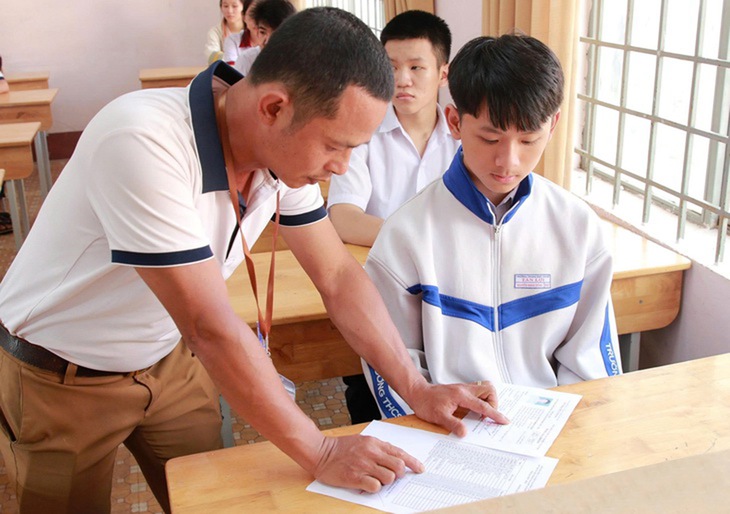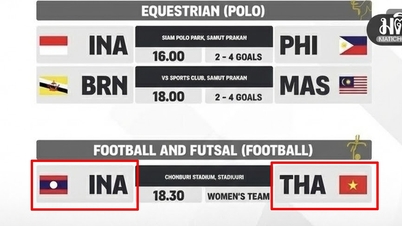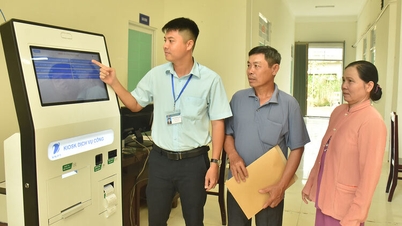
Candidates taking the 10th grade entrance exam in Dak Lak for the 2025-2026 school year - Photo: MINH PHUONG
In some places, candidates who scored less than 2 points per subject were still admitted to grade 10. This seemingly unbelievable number is ringing an alarm bell: Are we trading off the quality of general education by opening the door to grade 10 for everyone without a suitable support and streaming mechanism?
Reasons why 10th grade benchmark scores "hit rock bottom"
Some of the reasons why the benchmark scores "hit rock bottom" in the 10th grade entrance exam as they are now include:
First, the gap in education quality between regions when synchronously implementing the 2018 General Education Program nationwide.
This is due to the difficult socio -economic conditions in many remote and isolated areas, leading to limited investment in infrastructure, a lack of professionally trained teachers, and a lack of teaching equipment suitable to the requirements of innovation.
At the same time, students in these areas enter secondary school with a low input foundation and continue to face difficulties in the learning process due to a lack of a positive learning environment and inadequate support in the process of converting methods.
Meanwhile, urban students have advantages in terms of academic background, family conditions and support outside of school, thereby creating an increasingly large gap in educational quality between regions.
Second, the "gap" between curriculum - teaching - testing is getting bigger.
While teachers are required to move to competency-based learning and are still in the transition period for a comprehensive transition, the exam has approached the question-setting method to assess students' competencies. As a result, students who may perform at an average level in class can still get low scores because they are not familiar with the new exam format or the pressure of exams.
Third, the test may not accurately reflect the competency orientation and be close to the program's requirements, or the number of basic-level questions may not be large enough to "save" the group of candidates with average ability.
Many exams still rely heavily on memorization, practice, and tips, and lack practical situations, which goes against the orientation of developing qualities and abilities in the new general education program. In particular, the exams do not ensure balance between regions, creating a clear disadvantage for students in rural and mountainous areas.
Fourth, the knowledge base of grade 9 students is heavily affected by the COVID-19 pandemic, especially the online learning period, which is a huge difficulty for students in remote and isolated areas.
Propose some solutions
To fundamentally solve the problem of "low scores still being admitted" but input quality is not guaranteed, it is necessary to synchronously deploy the following solutions:
First of all, it is necessary to immediately analyze the results of the 10th grade entrance exam in 2025 by region and exam subjects to evaluate the quality of students in different regions and clearly understand the causes and especially analyze the exam questions using modern test analysis methods to know the suitability, reliability and value of the exam.
From the above analysis results, it will be clear that the core cause of low scores of some groups of students is due to student quality or ineffective teaching programs, methods, testing and assessment methods, so that appropriate plans can be made for students in the following years.
At the same time, research on applying a combined admission method of exams and regional selection to suit the admission subjects, ensuring consistency and fairness for disadvantaged groups.
Second, it is necessary to compare learning data from grades 6 to 9 with the entrance exam scores of grade 10 to identify learning trends and the stability or abnormality of the results. On that basis, it is possible to build an "assessment deviation" index to review the quality of assessment in educational institutions, and at the same time, recalibrate student assessment standards to match the new general education program and goals.
At the same time, it is necessary to review and adjust the matrix and specifications of periodic tests in schools in the direction of approaching the capacity, strengthening the assessment of the actual process, and training teachers on testing and assessment techniques according to the requirements of the program. This is an important step to ensure fairness, transparency and accuracy in reflecting the capacity of learners - not only in terms of scores but also in terms of future orientation.
Third, it is necessary to have activities to assess students' abilities from grades 8 and 9, and at the same time deploy a set of tools to support self-assessment of career interests and hobbies of learners, integrating career guidance activities and practical experiences in the main curriculum to proactively stream students from a distance, from an early age to help students choose to study in high school or vocational training that suits their abilities and strengths.

Candidates taking the 10th grade entrance exam for the 2025-2026 school year at Nam Dan 2 High School (Nghe An), with 2.5 points in three subjects, still passed the 10th grade of this public school - Photo: DOAN HOA
In the long term, it is necessary to develop a model of technical high schools that exist in parallel with current high schools, designed as high schools that integrate general cultural training and basic vocational skills (such as electricity - electronics, mechanics, high-tech agriculture, information technology...) suitable for regions to overcome the problem of lack of vocational secondary schools in difficult, remote and isolated areas as at present.
Students who graduate from technical high schools can take university entrance exams or go straight to work with a vocational certificate. In particular, it is necessary to create a mechanism for transferring and connecting horizontally between systems so that students studying at high schools can switch to vocational training and vice versa without having to start over.
Vocational secondary school students complete their cultural program to take the high school graduation exam. Establish a common data portal connecting academic records, abilities, strengths, and support counseling with appropriate roadmaps.
The difference between the final score and the exam score
Another core issue that has not been deeply analyzed in the picture of grade 10 admissions is the significant difference between the final subject scores at secondary school and the entrance exam scores.
Many students have average scores in their academic records that are good or excellent but only score very low in the entrance exam. This shows the large gap between the school's assessment and the entrance exam results - which are highly selective.
High academic scores but low test scores are not necessarily due to poor student performance, but may be due to the lack of standardized testing and assessment systems and lack of connectivity between levels. If not identified and addressed, the result is that the entire system will misjudge student performance, leading to errors in career orientation and streaming.
Streaming does not mean separating classes based on scores, but rather reorganizing the system so that each student has the opportunity to develop their abilities in an open and flexible way, with changes according to the learner's development ability. To do so, we need to change not only the examination process, but also the thinking of designing school models and long-term educational strategies.
Misunderstanding about streaming
Reality shows that many students only start thinking about vocational training or vocational secondary school after failing to pass the 10th grade exam. Streamlining then becomes a "passive solution", not an educational strategy.
This leads to three major problems: (i) streaming is misunderstood as eliminating weak students instead of orienting them according to their abilities; (ii) lack of early ability identification tools makes students and parents not know which path is suitable; (iii) there is no clear connection mechanism between high school - vocational school - continuing education center, so the learning path lacks flexibility.
Source: https://tuoitre.vn/khi-diem-chuan-vao-lop-10-cham-day-20250710090847797.htm



![[Photo] Parade to celebrate the 50th anniversary of Laos' National Day](/_next/image?url=https%3A%2F%2Fvphoto.vietnam.vn%2Fthumb%2F1200x675%2Fvietnam%2Fresource%2FIMAGE%2F2025%2F12%2F02%2F1764691918289_ndo_br_0-jpg.webp&w=3840&q=75)
![[Photo] Worshiping the Tuyet Son statue - a nearly 400-year-old treasure at Keo Pagoda](/_next/image?url=https%3A%2F%2Fvphoto.vietnam.vn%2Fthumb%2F1200x675%2Fvietnam%2Fresource%2FIMAGE%2F2025%2F12%2F02%2F1764679323086_ndo_br_tempimageomw0hi-4884-jpg.webp&w=3840&q=75)





































































































Comment (0)